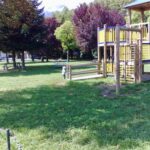INTERDISCIPLINARY NATURE STUDY SHOWS THAT INNER TOWN GREEN DIRECTLY INFLUENCES ON CITY RESIDENTS
Inner city green areas such as lawns, flowerbeds, trees or parks can directly improve the well-being of city dwellers. These are the findings of a recent study conducted by scientists from GIScience Research Group at Heidelberg University and the Heidelberg Institute for Geoinformation Technology (HeiGIT) together with the Central Institute for Mental Health (ZI) in Mannheim and researchers from the Mental HMealth Lab at the Karlsruhe Institute of Technology (KIT). It was also examined who benefits from this effect. The research results were published in “Nature Neuroscience”
https://www.nature.com/articles/s41593-019-0451-y ).
In order to examine the effect of green spaces in cities on well-being in everyday urban life, 33 healthy city dwellers were asked to rate their mood several times a day for one week using specially equipped smartphones. The participants went about their everyday life as usual during this time. Using geo-informatics methods, it was possible to trace the paths covered and identify green areas in that area. It has been shown that the subjects showed a higher level of well-being in situations where they were surrounded by a higher proportion of green space. In a second step, 52 other young adults were asked to rate their mood in everyday life in the same way. The evaluation confirmed the results from the first part. In addition, these participants were subjected to functional magnetic resonance imaging after the seven-day assessment phase. This method allows to represent certain brain functions. The researchers observed a diminished activity in the dorsolateral prefrontal cortex in people who responded positively to the green areas in their everyday lives. It is a brain region that has a central control role in processing negative emotions and stressful environmental experiences. In the words of Prof. Dr. med. Andreas Meyer-Lindenberg, CEO of the ZI and Medical Director of the Department of Psychiatry and Psychotherapy, suggest these results that green spaces are particularly important for people whose capacity to regulate negative emotions themselves is diminished. According to Markus Reichert of the Mental MHealth Lab of KIT, who together with the ZI researchers Dr. Ing. Urs Braun and Prof. Dr. Dr. Heike Tost and the Heidelberg GIScience researchers is one of the first authors of the study, green areas distributed well over a city could develop a considerable potential for prevention with regard to mental illnesses
As Prof. Dr. Alexander Zipf, head of the GIScience Research Group at the Institute of Geography of Heidelberg University explains, it is the innovative combination of methods in the fields of epidemiology, psychology, geoinformatics and neuroimaging that has made these socially relevant study results possible. Practical application of the results can for example be found in urban planning. “Geoinformatics is playing an increasingly important role in research on environmental issues,” says Dr. Sven Lautenbach from the Heidelberg Institute for Geoinformation Technology (HeiGIT), which is also headed by Prof. Zipf. The study also supports current research on healthy and green routing. Here, route planning systems are developed that suggest user-dependent pedestrian routes that have particularly high shares of green areas or particularly low noise levels.
Original publication:
H. Tost, M. Reichert, U. Braun, I. Reinhard, R. Peters, S. Lautenbach, A. Hoell, E. Schwarz, U. Ebner-Priemer, A. Zipf, and A. Meyer-Lindenberg (2019): Neural correlates of individual differences in affective benefits of real-life urban green space exposure. Nature Neuroscience (published online 29 July 2019). https://doi.org/10.1038/s41593-019-0451-y



